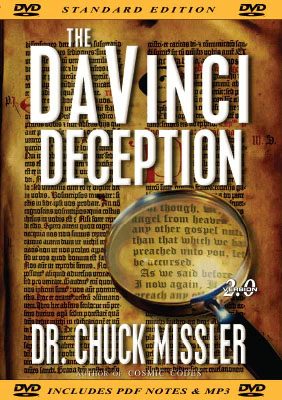As we said before, so say I now again, If any man preach any other gospel unto you than that ye have received, let him be accursed.
Galatians 1:9
Last months issue of National Geographic magazine featured an article about a 1,700-year-old manuscript discovered in Egypt. The manuscript claims to tell the story of Christs last days from the point-of-view of history's most notorious traitor. This so-called ''Gospel of Judas'' is only one of several non-canonical gospels, collectively referred to as the ''Gnostic Gospels.'' Scholars widely agree that none of these texts contain historically reliable information about the life of Jesus and that all were likely written in the second century or later. However, they do help us learn more about the Gnostic teachings that early church leaders like the Apostle Paul preached against in the book of Colossians and elsewhere.
Also last month, the film adaptation of Dan Browns controversial book The DaVinci Code opened in theaters worldwide. Despite the fact that the book is a work of fiction, it has raised many troubling questions, particularly among the uninformed. It has also challenged many in their understanding of the Biblical texts. No doubt this movie will continue to be a hot topic of conversation, particularly in the coming weeks. Therefore, it is important for us as Christians to be prepared to answer questions about our faith and to defend the authenticity of Gods Word.
In his novel, Dan Brown attempts to support his outrageous notions by using allusions from the ''Gnostic Gospels'' and twisted distortions of the early church councils, all of which raise serious questions: What makes us so confident that our Bible is what it purports to be? How do we know? What about these ''missing'' books of the Bible?
Browns distortion of history is rampant throughout his novel. He assumes that Constantine made Christianity the state religion of the Roman Empire - rather, he simply granted freedom of worship in his Edict of Milan in A.D. 313. It was a subsequent successor, Theodosius (379-395), who made Christianity the state religion in 381. Browns Constantine ''upgraded a mortal Christ to deity,'' and ''secured male dominance and suppression of women''... ''converting the world from matriarchal paganism to patriarchal Christianity.'' He insists that Constantine canonized selected favorable Gospels from ''more than 80 available.'' His deliberate distortions are, of course, contradicted by clear historical records.
Nicene Creed We believe in one God, the Father Almighty, maker of all things visible and invisible, and in one Lord, Jesus Christ, the Son of God, the only-begotten of the Father, that is, of the substance [ousias] of the Father, God from God, light from light, true God from true God, begotten, not made, of one substance [homoousion} with the Father, through whom all things came to be, those things that are in heaven and those things that are on earth, who for us men and for our salvation came down and was made flesh, and was made man, suffered, rose the third day, ascended into the heavens, and will come to judge the living and the dead. |
Council of Nicaea
The Council of Nicaea was convened in A.D. 325 with 318 bishops to settle disputes about Christology, not to dispute or modify the ''canon.'' (''Canon,'' meaning standard, refers to those Scriptures that were accepted by the early churches as God-breathed, or inspired.) The principal precipitating issue was between Arius and Athanasius. Arius argued that Jesus was simply a created being. He was a great communicator and was causing deep disputes throughout the Empire. Athanasius argued for the full deity of Christ and was clearly vindicated by the proceedings of the Council (as exemplified by the famous Nicene Creed, above).
Browns Version
''It was at the Council of Nicaea in 325 that Church leaders decided by vote to make Jesus divine...Until that moment in history, Jesus was viewed by His followers as a mortal prophet.''
And, according to Brown, it was a ''close vote''! According to him, the presently accepted Gospels were selected from ''more than 80'' available. All of this is deliberate misrepresentation to support his attack on Jesus Christ and His church.
Twenty rulings were issued at the Council of Nicaea and the contents of all of them are still in existence: not one of them involved issues regarding the Canon. As for the vote that was finally taken, only 5 out of 318 dissented; only two of those refused to sign the resulting resolutions, which reaffirmed the deity of Christ, not issues regarding the canonical Gospels.
How We Got the New Testament
The New Testament was canonized in the 1st century while the apostles were alive and all facts could be checked out (Lk 1:2; Acts 1:21,22; 1 Jn 2:3). It was endorsed by Christ in advance (Jn 14:25-26) and was considered a ''more sure word of prophecy'' (2 Pet 1:16-19).
The Process
Letters were received and then circulated by the early church, and a growing group of them became recognized as authoritative (Apostolic) and in harmony with accepted doctrine. All 27 books were accepted by the end of the 1st century and every New Testament book was cited as authoritative by a church father within one generation.
The Gnostic Gospels
The term ''Gnostic'' refers to gnosis, or knowledge. However, here it refers to the concept of hidden, secret, or special knowledge. The Gnostics were a growing problem in the early church and many of the New Testament epistles, as well as the numerous quotes from the early church fathers, were in rebuttal to the several heresies promoted by the Gnostics.
(In fact, Paul's second letter to the Thessalonians was a response to a forgery being circulated as if from him.1)
For the time will come when they will not endure sound doctrine; but after their own lusts shall they heap to themselves teachers, having itching ears; And they shall turn away their ears from the truth, and shall be turned unto fables.
2 Timothy 4:3
A large number of spurious documents emerged during the centuries following the ministries of the Apostles and were universally rejected by the early church. Copies of a group of these were found at Nag Hammadi (in Egypt) dating from the 3rd and 4th centuries, and these are uncritically accepted by Brown as accurate. These include The Gospel of Thomas, The Gospel of Philip, The Gospel of Mary, The Gospel of Truth, and about four dozen others.
They are not ''Gospels'' at all, but rather speculative opinions, totally devoid of any verifiable facts. Furthermore, they were written under false pseudonyms in an attempt to gain legitimacy. The early church rejected any documents under pseudonyms as being inconsistent with the concept of God-breathed inspiration.2
Lastly, they were all written centuries after the Gospel period - in contrast to the contemporaneous eyewitness accounts in the New Testament - and make no pretense of being actual records of events - in fact, they are anti-historical rather than simply non-historical!
In particular, Brown leans on The Gospel of Philip and its out-of-context fragmentary reference to a kiss - in which Jesus ostensibly kissed his other students as well - but this still suggests nothing about marriage or any sexual innuendo. Brown leans on a word in the ''Aramaic'' (although The Gospel of Philip came to us in Coptic!) that he maintains means ''spouse.'' The word actually happens to be a loan word from the Greek: koinonia, which can mean companion, as in fellowship, etc.
The Gospel of Philip makes no reference that supports any of Browns contentions. But even if it did, it would be irrelevant since it was written more than two centuries after the Gospel period, under a pseudonym posing as someone he wasn't. No serious scholar can take it seriously as having any historical merit.
(Many would seem to accept Napoleons cynical perspective: ''What is history, but a fable agreed upon?'')
The popular novel is, indeed, malicious, deliberate fiction - posing subtly as factual - and is clearly, itself, a fulfillment of prophecy:
Even as there shall be false teachers among you, who privily shall bring in damnable heresies, even denying the Lord that bought them, and bring upon themselves swift destruction. And many shall follow their pernicious ways; by reason of whom the way of truth shall be evil spoken of. And through covetousness shall they with feigned words make merchandise of you:
2 Peter 2:1-3
But it can also be a blessing by causing serious Christians to do their homework and find out just how the Bible came into being and the process by which the New Testament achieved codification during their early years.3
For there must be also heresies among you, that they which are approved may be made manifest among you.
1 Corinthians 11:19
Notes:
- 2 Thessalonians 2:2.
- The Epistle to the Hebrews is the notable exception. It appears to be the 3rd of a trilogy on Habakkuk 2:4, along with Romans and Galatians.
- These topics are covered in our Learn the Bible in 24 Hours publications, and also in our briefing package, How We Got Our Bible (see the K-House Online Store for details).






